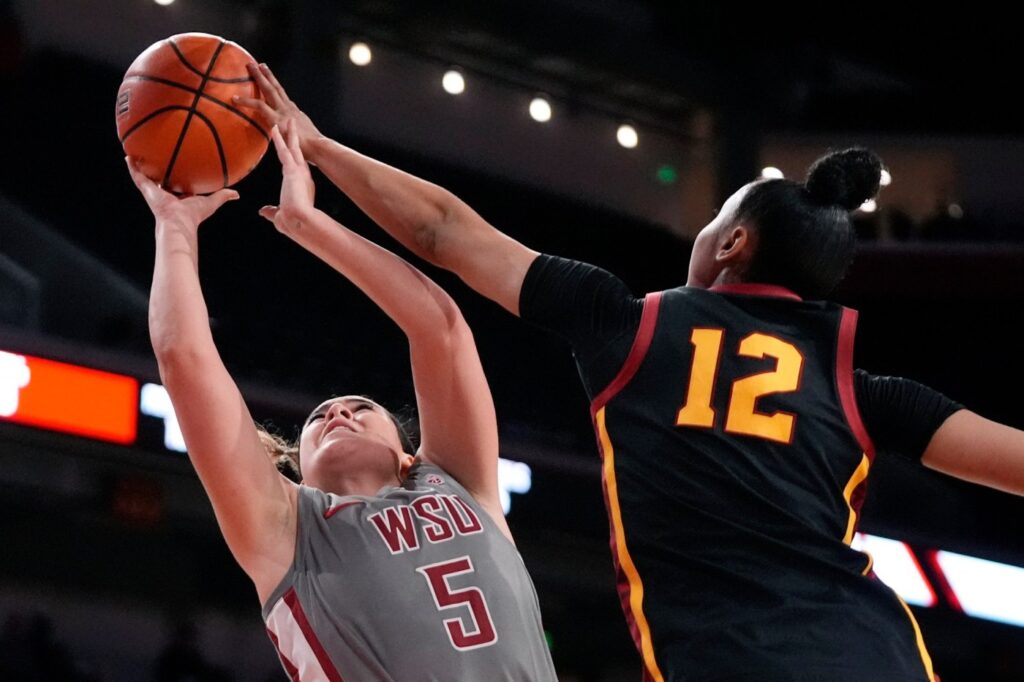
LOS ANGELES – Rayah Marshall grinned as if she were the keeper of a kingdom’s tactics, backpedaling quickly away from a question about customs that have buoyed the USC women’s basketball team’s recent defensive surge.
“The defensive goal chart,” Marshall said, walking away after Thursday’s practice, flinging morsels of information over her shoulder with a smirk in her voice. “If you know, you know. That’s all I could say about that.”
This is USC’s best-kept secret. Except it’s hardly a secret if you spend a minute with Beth Burns, USC’s defensive guru and Lindsay Gottlieb’s right-hand woman, who has implemented and popularized her own system of subjective defensive analytics – this “goal chart” – that the entire program has bought into.
Back during her second stint from 2005-2013 as the head coach of San Diego State, Burns and the Aztecs took a trip up to play Saint Mary’s. Burns knew longtime Saint Mary’s men’s coach Randy Bennett from his early coaching days at the University of San Diego; as such, Bennett offered to let Burns and her staff shower in the men’s locker room before they returned home. And in the locker room, Bennett’s whiteboard caught Burns’ eye: scrawled with figures and words like defensive percentage.
Burns, for long years, had mulled the lack of empirical data available to measure defense. From basketball’s beginning of time, she explained with youthful enthusiasm Thursday, it was easy for players to empirically digest offensive performance: shoot 1-for-14, you played bad. Defense, she continued, was “more just, your coach saying, ‘You stink.’”
So when San Diego State returned home, Burns called Bennett, and asked him about the system on his whiteboard. It provided the seeds for a defensive metric system that Burns has morphed and developed across the recent years of her coaching career, first bringing it to Louisville, then back to USC.
Every Tuesday, Burns breaks down video clips of every single possession in which an opposing team scored to USC players, assigning them a certain number of points and an efficiency score derived from a simple formula. It has worked wonders for a USC program that now sits at 20-4 and seventh in the AP Top 25, shooting up to second-place tie in the Pac-12 after a six-game conference win streak. Freshman JuJu Watkins’ offensive explosions have been deservedly well-documented; USC, though, has hit its stride in large part because of swarming defensive effort, Watkins shooting a near-unholy 6-for-32 at Oregon State last Sunday and the Trojans still fighting to a win by holding the Beavers to 33% shooting.
“This is the secret sauce of it,” Burns smiled Thursday, getting ready to explain her system.
Here are the specifics. On plays where an opponent scores, Burns assigns those points to the USC defender or defenders directly responsible under the Trojans’ defensive scheme. Say a perimeter defender was supposed to force someone baseline, and they went middle for a layup – Burns assigns that defender two points. Say a big doesn’t box out and it turns into a three – Burns assigns that big three points.
Individual points, then, are compiled into a simple equation: points divided by minutes played, for a stat Burns calls simply “D%.” Anyone with a score of 29% or lower (which, if prorated to an entire team’s output, would lead to 60 points or less being surrendered), Burns defines as being in the “green” zone. Anyone 39% or lower, in the yellow zone. Anyone above 39%, in the red zone.
“And you do not want to be red,” Burns grinned.
Across the last three games, half of USC’s roster has been in the green. Players have become accustomed, Burns said, to coming into film sessions, watching their mistakes, and bickering with her over their scores. The program, Gottlieb said Thursday, has improved in their understanding of defensive coverages, a trend that shows both in simple stats – USC hasn’t surrendered more than 70 points since mid-January – and in Burns’ metrics. As Burns sat in a baseline seat after Thursday’s practice, she stopped an exiting Kayla Padilla for a moment, gushing in awe over the senior’s game Feb. 12 against Arizona in which Padilla wasn’t tabbed for any points on Burns’ system.
Related Articles
USC loses RB coach Kiel McDonald to Chargers
USC women hand Oregon State its first loss at home this season
USC fails to close another game in a double-overtime loss to Colorado
JuJu Watkins, No. 10 USC women crush Oregon
Bronny James’ defensive chops shining for USC through inconsistent playing time
“I’ve been doing this chart a long time, buddy, and I don’t know anyone’s done a 0 in 30 minutes,” Burns said, Padilla placing her hand over her heart with a smile.
“Thanks, Coach B,” Padilla responded.
The metric has spilled outside of practice courts and film rooms, Burns discussing Padilla’s score excitedly with senior McKenzie Forbes in a Galen hallway long after practice wrapped up Thursday, the foundation of a program approach that has seen widespread individual defensive improvement. There’s Watkins, who racks up deflections nearly as frequently as she does points. There’s Marshall, who Gottlieb praised as “quarterbacking” USC’s defense from the paint. There’s Padilla, who’s taken personal pride in her ascension from a score-first guard at Penn to a point-of-attack defender at USC.
“When you’re playing, sometimes, it’s like, ‘Ope — well, that’s another two points on the D-chart,’” Padilla said.
USC vs. Colorado
When: Friday, 7 p.m.
Where: Galen Center
TV/radio: Pac-12 Network/790 AM
